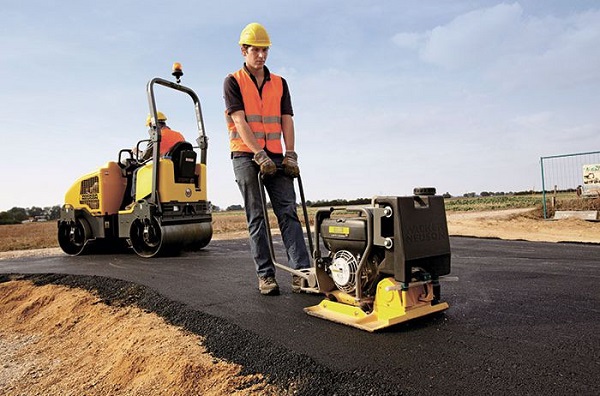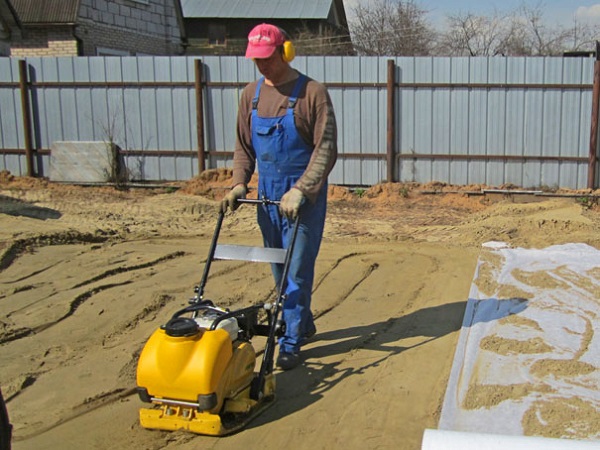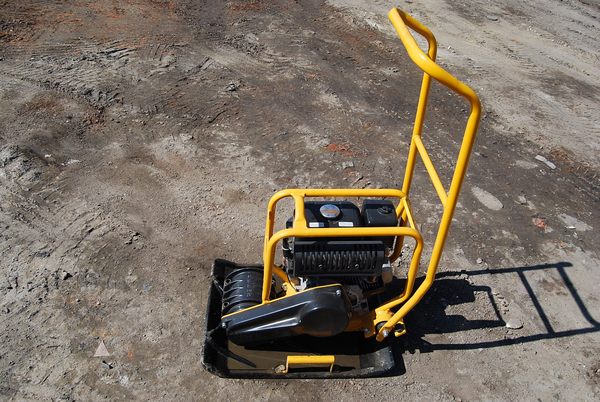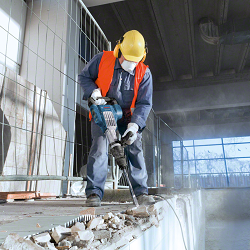How to perform compaction using a vibrating plate
Compaction of soil and other bulk materials is an event that constantly accompanies various construction works. Previously, they were tamped by hand, and now they use the vibro-ramming method using vibrating plates. Manufacturers offer a wide range of equipment of this type, equipped with diesel, gasoline or electric engines. Starting the operation of equipment, to achieve the result of the required quality it should be borne in mind that tamping of different materials has its own characteristics. In order for the sealing mechanism to serve for a long time, it is necessary to operate it correctly. At the same time, adherence to safety precautions will avoid injury.
Content
Scope of use of the vibrating plate
The vibrating plate is designed for tamping with oscillatory effect such bulk materials:
- gravel;
- sand;
- rubble;
- loose soil.

Separate particles of these materials in the freshly poured pillow under the foundation of the building are not located tightly to each other. To bring them as close as possible to each other, perform tamping. This improves the bearing properties of the poured layers, allowing the construction of various objects on their surface.
The scope of vibrating plates affects many areas of construction. Vibrotramping is widely used in the following works:
- road construction;
- arrangement of lawns;
- the device of filling pillows under the bases of various types for the most different constructions, and also under floors of big buildings;
- laying asphalt pavement;
- construction of parking lots, sports grounds;
- consolidation of a bottom of ditches and trenches under various engineering communications.
Laying paving slabs and paving stones is also accompanied by the use of vibration plates. This speeds up the performance of work at times.
Rules for tamping with a vibrating plate
Tamping of soil, sand, gravel or rubble has its own characteristics that are associated with the properties of these materials. If they are not taken into account, then it will not be possible to compact the poured layer, which will further affect the durability of the erected structure.
Vibrating plates by weight are divided into several groups. The greater the weight of the unit, the greater the thickness of the layer of poured bulk material can be rammed with it. Getting started, you should consider such nuances.
- Light equipment (weighing up to 75 kg) can increase the density of a layer with a thickness of 15 cm, therefore it is widely used in landscape works and when laying paving slabs.
- Universal models technicians (weighing 75-90 kg) can already tamp down 25 cm of the poured material. They are used when laying asphalt, as well as in partial repair of roads.
- Medium gravity aggregates (weighing 90-140 kg) are designed to work with layers up to 60 cm thick. With their help, fill the trenches and trenches, as well as the construction of road embankments.
- Heavy Vibration Equipment (weighing more than 140 kg) is used to perform the same working operations as the moderate technique.
The table below shows the suitability of vibration plates of different weights for tamping different materials.

From the table it is clear that loosely coupled soils (dust) it is more effective to tamp with vibration equipment weighing from 300 to 950 kg.
Vibrating plates are not suitable for compaction of clay soils and loams. In such cases, use vibrorammers or vibratory rollers (for large amounts of work).
When working with a vibrating plate, the following general tips should be followed:
- it is necessary to take into account the characteristics of tamped surfaces;
- it is impossible to pass separate sites;
- The optimal number of passes is from 4 to 6;
- the maximum layer thickness must match the capabilities of the equipment used;
- the surface of the prepared site should not have differences in excess of 2 cm;
- each level of the multi-layer cushion is compacted separately;
- it is necessary that the building materials used comply with their properties GOST.
As for how much speed should be on a vibrating plate, here is the following pattern: the higher the frequency, the more convenient it is to work with small fractional soils. For example, for compaction of crushed stone or gravel with the size of individual stones up to 10 mm (or less), as well as sand, equipment with 6000 rpm is well suited. If the stone is 6 cm in size, you can use the device from 3000 rpm.
The nuances of compaction of various materials
Starting compaction of rubble or other bulk material, you must first remove the existing on the surface of the working area garbageFor example, pieces of planks, cobblestones, bricks.
Sand
Vibration compaction of sand is performed as follows:
- the building site is filled with sand with a layer no more than 0.6 meters thick, depending on the mass of the vibrating equipment being used;
- moisten the entire area of the rammed area evenly with water;
- vibrating plate the whole area four times;
- if the required degree of compaction is reached, then, if necessary, pour the next layer;
- repeat the whole process of ramming the bulk.

As a result sand compaction factor when tamping with a vibrating plate must be at least 0.95.
Work near columns or walls may require additional (more compact) equipment.
If tamping sand is performed without pre-wettingthen there will be a lot of dust. This will quickly lead to clogging of the air cleaning filter during operation of gasoline units. At the same time, it is impossible to pour too much water on the sand filling so that it does not remain in the existing voids, hindering this normal binding of particles of material (grains of sand). Only a moderate amount of fluid creates a cementing effect.
Shcheben
Compaction of rubble is complicated by the fact that this material is presented fractions of different sizes. It is necessary immediately before work to determine the maximum thickness of the poured layer for tamping. After 4 passes of the vibrating plate on the treated surface, the rubble mass (or gravel) should be compacted by about 95%. If it still remains sufficiently free-flowing, then the subsequent tamping makes almost no sense: it is necessary to pour the material with less scrap.
It is recommended to start tamping with a minimum thickness, gradually increasing this parameter to achieve the desired ratio between performance and workmanship.This will allow to determine the optimal height of the poured layer.
When using a limestone type of rubble is often found blading effect - adhesion of the stones of the upper layer with each other when exposed to vibrations emanating from the plate. As a result, the underlying mass of material is not compacted. This effect can be overcome with the help of heavy (weighing more than 150 kg), powerful vibration aggregates. With a weight of 100 kg in use of a slab, only a fraction of rubble with stones ranging from 10 to 20 mm is suitable.
Paving slabs
When paving slabs are laid, special equipment is attached to the working plate of the vibration equipment. polyurethane or rubber mats, so as not to damage the created coating. Due to their performance properties, polyurethane plates are preferable because they do not leave black marks on the surface of the tiles and are more wear-resistant.
Safety at work
Soil tamping with a vibrating plate must always be carried out in compliance with safety regulations. Among the many recommendations are the following basic rules.
- During the work it is necessary to apply personal protective equipment: appropriate clothing and shoes, glasses, headphones, headgear.
- Before using, check the used equipment for external damage: if they are, then they should be repaired.
- It is forbidden to leave working equipment without control, while the operator must be located behind him and in time to move behind the unit.
- Every 40 minutes you need to organize a break for about 10 minutes to prevent operator fatigue.
- You can not further speed up the mechanism with the help of additional efforts.
- If you need to work on inclined surface (when the angle does not exceed the norm), the service personnel must stand above the unit, moving from top to bottom.
- It is prohibited to operate the technical device near sources of explosive or easily flammable materials.
- At tipping plate, it should be previously turned off, and only then put in a working position.
- The machine is deployed with one hand.
- To prevent injury, keep your feet and hands away from the working sole of the slab.
- In the event of a collision with an obstacle, you need to stop the unit, and then remove the obstacle and possible damage caused by it.
- From the edges of trenches, trenches, ravines and other grooves are required to be no closer than the minimum allowable distance, and better away.
- It is strictly forbidden to allow people who are under the influence of drugs, alcohol or psychotropic drugs to work.

It should be taken into account that the higher the center of gravity of the vibration equipment (and the smaller the support area), the easier it can roll over. This is very dangerous for the operator. Also very carefully you need to handle while turning on the technique, not equipped with a soft start function.
To increase the degree of safety of work, especially in a confined space, it is recommended to give preference to models with remote (remote) control, despite their high cost.
Use of the vibrating plate is required when carrying out all construction actions which are connected with consolidation of loose soil. It is necessary to take into account the characteristics of the rammed materials in order to achieve a quality result.It is necessary that the maximum depth of the poured layer corresponds to the thickness that the operated unit is able to tamp. Safety must always come first. Failure to follow simple rules along with inattention can lead to serious injury.

/rating_off.png)











